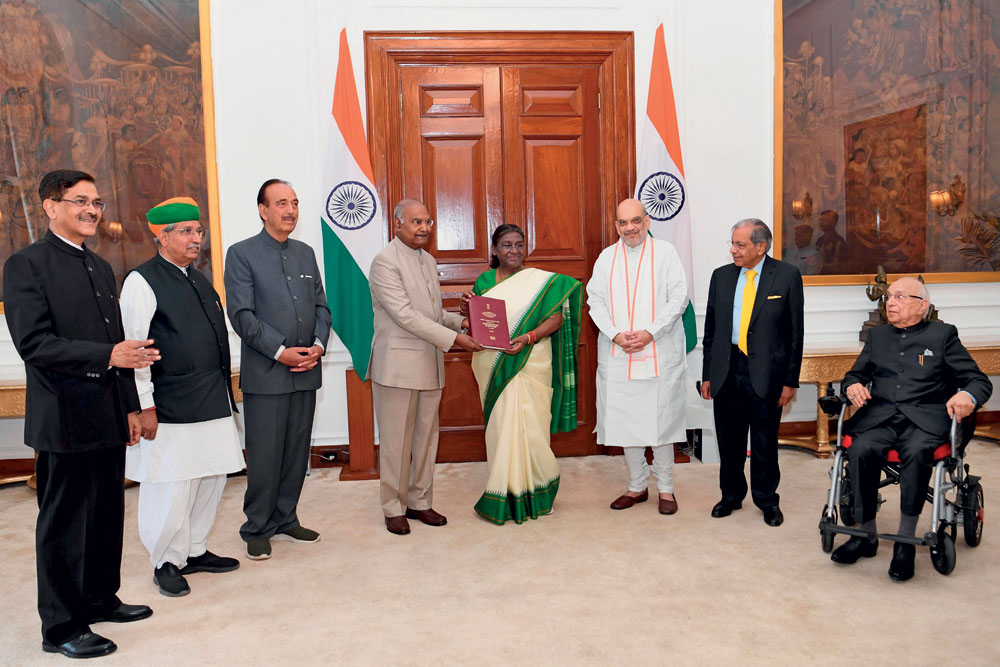In Defence of One Nation One Election
The economic benefits of simultaneous polls will be far-reaching
 Siddharth Singh
Siddharth Singh
 Siddharth Singh
Siddharth Singh
 |
22 Mar, 2024
|
22 Mar, 2024
/wp-content/uploads/2024/03/Onenation1.jpg)
(Illustration: Saurabh Singh)
WHAT’S COMMON TO farmers in Punjab who ‘went slow’ in repaying loans in 2017 and their counterparts in Chhattisgarh who adopted a ‘wait and watch’ approach in late 2019 before taking their rice crop to the market? In one word: elections. What makes the problem worse is the non-synchronised nature of elections, leading to a near-constant pitch of populism, month by month, year by year. The report of the High-Level Committee on Simultaneous Elections (HLC), released earlier this month, details the economic costs associated with this “dance of democracy” and they happen to be exorbitant. The way out of the problem? Simultaneous elections at all levels at one-go, from local bodies all the way to Parliament.
There are many mechanisms by which costs to the economy add up in the years before and after staggered elections. The foremost channel is the sheer level of populism indulged in by parties, one that is well-anticipated by voters.
Back in May 2017, some two months after the Assembly election results were declared in Punjab, some 30 per cent of accounts held by farmers in banks turned ‘irregular’ as their holders expected the Congress government in the state to waive their bank loans. Something similar happened with the rice crop in Chhattisgarh two years later, as Congress had promised farmers higher procurement prices during a heated election campaign. And the party stuck to its promise.
It sounds unfair to single out two states and an individual political party for election-eve populism. But the reality of economic populism in India is such that, once unleashed, all political parties have to respond in one way or another lest they risk being edged out of elections. The examples can be multiplied across India’s elections, especially since the time elections to Parliament and state Assemblies became ‘desynchronised’. In the early decades after Independence, elections to Parliament and Assemblies were held together. Since 1986, however, there has not been a single year when a state Assembly election did not occur. Between 2019 and 2013, there were 31 elections to Parliament and state Assemblies, at 6.2 elections per year.
The costs are exorbitantly high. To cite another example, in the run-up to the Assembly elections in Karnataka, Congress promised “five guarantees”. These included free electricity (up to 200 units), free bus travel for women, monthly allowance of ₹2,000 for the woman head of a family, and more. At that time, the estimated cost of these guarantees was ₹50,000 crore per year but subsequently—after Congress was voted to power in the state—these costs escalated. But irrespective of the gap between estimated costs and the money that has to be shelled out from the state exchequer, the promise of these guarantees worked wonders for Congress. The Bharatiya Janata Party (BJP) government in the state did not offer a set of counter-populist measures and stuck to fiscal prudence. The party was roundly defeated. A similar set of measures was announced for the Assembly polls in Telangana later in 2023. And there, too, Congress romped home.
On March 19, Congress expanded the scope of its populism and announced 25 new “justice” guarantees at the national level for the forthcoming parliamentary elections, without announcing any cognate measures on how these would be funded. It is another matter that Karnataka—once a revenue-rich state—is now reeling from the effects of the five guarantees rolled out last year.
The economic gain in case elections are conducted simultaneously: assuming that the gain of 1.5 percentage points of GDP is invariant over time, the gain in rupee terms will only go up over time. If India were a $5 trillion economy today, the gain from simultaneous elections would be close to ₹6.22 lakh crore
Another mechanism by which expenses go up during the election season is the sheer cost of electioneering and running party campaigns. This is over and above the administrative costs of holding elections. The latter costs, which are far less than the overall costs, too, have dramatically gone up over the decades. For example, for the first General Election in 1952, which also included Assembly polls, the cost was ₹10.5 crore. By 2014, when elections across parliamentary and Assembly elections were de-synchronised, these costs had risen to ₹3,870 crore, 368 times what it cost to run elections in 1952. The Centre for Media Studies (CMS) estimated these costs to be around ₹10,000 to ₹12,000 crore in 2019. But these ‘formal’ costs are just 10-15 per cent of the overall cost of elections.
The 2019 election season was probably the most expensive so far in India’s electoral history. CMS estimated an overall cost of ₹55,000-60,000 crore with campaign and publicity alone accounting for ₹20,000-25,000 crore. This is well above the Election Commission of India’s (ECI) ceiling on election expenditures. Even with constant vigilance on ECI’s part—an army of election and expenditure observers fans out across the country to look for transgressions—it is of no avail. These costs will continue to mount in the years and decades ahead.
The most interesting part of the HLC report is the section on the economic and social costs of desynchronised elections. The committee commissioned a special study to examine these costs. The study used the most up-to-date econometric technique— Difference in Difference (DiD) methodology—to evaluate the economic consequences of staggered elections.
The committee noted: “Overall, this myriad of direct and indirect mechanisms can be far more substantial than official expenditures by the government in conducting elections. From an economic perspective, the resources employed in electoral cycles can be associated with significant opportunity costs, all with implications for the macro economy.”
But it is the actual economic effects of elections—if conducted simultaneously—that are breathtaking. The committee’s estimates are worth quoting fully: “The estimates suggest that on average, real GDP growth is higher following episodes of simultaneous elections, while we find a decrease post the non-simultaneous episodes. The magnitudes suggest approximately 1.5 percentage points higher post-pre difference in growth as compared to non-simultaneous elections. To put the magnitudes in perspective, 1.5 percent of GDP is equal to ₹4.5 lakh crore in FY2024, half the public spending on health, and one third that on education. Publicly reported estimates of conducting national and state elections, beyond the official costs of conducting elections, range from ₹3-7 lakh crore, which are close in order of magnitude to our growth estimates.”
THERE ARE TWO ways to look at these effects. One is to see the economic gain in case elections are conducted simultaneously. Assuming that the gain of 1.5 percentage points is invariant over time, the gain in rupee terms will only go up over time. If India were a $5 trillion economy today (assuming a dollar-to-rupee exchange rate of 83), the gain from simultaneous elections would be close to ₹6.22 lakh crore. There are, of course, multiple assumptions in such a calculation (such as the exchange rate to cite one) but the direction is clear—there are substantial gains to be had from simultaneous elections.
The second way to look is through the prism of gains foregone in case elections are not held simultaneously. At their simplest these would be the exact obverse of the numbers mentioned earlier. But because there is not a single year when Assembly or other elections are not conducted, these costs would be substantially higher than the 1.5 per cent of GDP cost. So far, there are no systematic studies that look at how these costs have evolved on a year-by-year basis as well as on the basis of election cycles over time. In case these costs are not invariant, say they increase over time—as has been observed since elections began in 1952—the gains from holding simultaneous elections would be even more impressive and, in reverse, the costs ever more daunting.

There are other economic effects as well. For example, the HLC study found that “[on] average, the Consumer Price Index (CPI) inflation rate was lower during simultaneous election episodes in the pre-election period compared to the non-simultaneous ones. While the inflation rates tend to fall around both simultaneous and non-simultaneous episodes, they tend to fall more around simultaneous episodes. The magnitudes suggest a difference-in-difference estimate of 1.1 percentage points or a larger fall in inflation of around one percentage point around simultaneous elections compared to non-simultaneous elections.”
Again, this is not too hard to understand: such heavy expenditures incurred in a short span of time—when any economy, let alone the Indian one—is supply-constrained can have only one effect: the prices of goods demanded go up. The effect fans out more when elections are a near-constant phenomenon on an annual basis. If they were to be a once-in-five-years event, inflationary dynamics would be very different.
There are other effects as well that the study explored, such as the effect of elections on investment. This, too, is not hard to understand. Elections have an unsettling effect on investor sentiment. In India, elections are always an uncertain affair—parties often lose and governments change. The result is policy uncertainty of a kind unknown in any economy comparable to India’s. As a result, investors wait for political certainty and policy clarity. That, in turn, leads to investments being held off until investors are certain about the policy environment.
In India, elections are always an uncertain affair. The result is policy uncertainty of a kind unknown in any economy comparable to India’s. As a result, investors wait for political certainty and policy clarity. That, in turn, leads to investments being held off until investors are certain about the policy environment
It is not surprising that the HLC concluded: “the loss of simultaneity in elections after the first two decades of India’s independence has had a baneful effect on the economy, polity and society.” It went on to say: “This casts a huge burden on the Government, businesses, workers, Courts, political parties, candidates contesting elections, and civil society at large. The Committee, therefore, recommends that the Government must develop a legally tenable mechanism in order to restore the cycle of simultaneous elections.”
These recommendations must be seen in the light of other attempts made to fix the problem of economic populism on the eve of every election cycle. In October 2022, ECI proposed a modification of the Model Code of Conduct (MCC). The amendment to MCC, had it gone through, would have required parties to provide details of the funding of their electoral promises. To that end, ECI sent a detailed note to all political parties in India asking them to provide details of the financial implications of their promises, including the likely expenditure on each beneficiary and an estimate of the total expenditure on such promises. In no time, there was a furore, with major parties saying ECI had “exceeded its brief”. The result was an impasse. The Supreme Court, too, held hearings on “freebies” but the process went nowhere. India’s “promise-addicted” political parties would have none of it. It makes immense political sense to promise the moon to voters but it is another matter that this is less than rational for the health of the Indian economy. It is time simultaneous elections were given a chance to get India out of the populist cul-de-sac.
About The Author
MOst Popular
3

/wp-content/uploads/2025/07/Cover-Shubman-Gill-1.jpg)












More Columns
Nimisha Priya’s Fate Hangs In Balance, As Govt Admits It Can’t Do Much Open
Roots of the Raga Abhilasha Ojha
An Erotic Novel Spotlights Perimenopause Nandini Nair